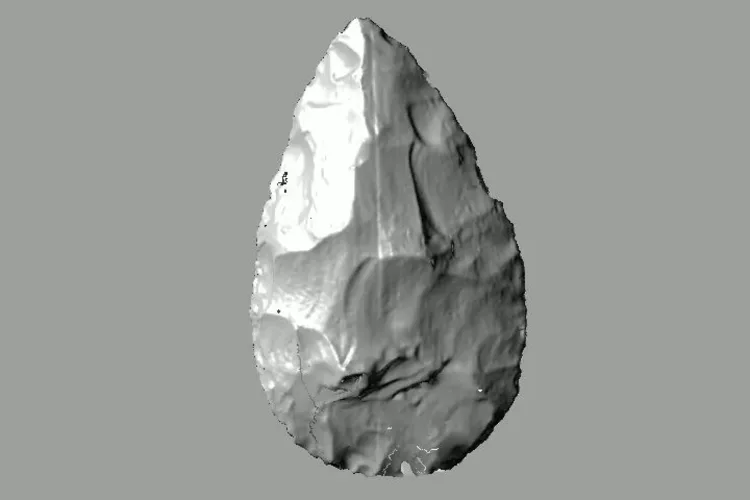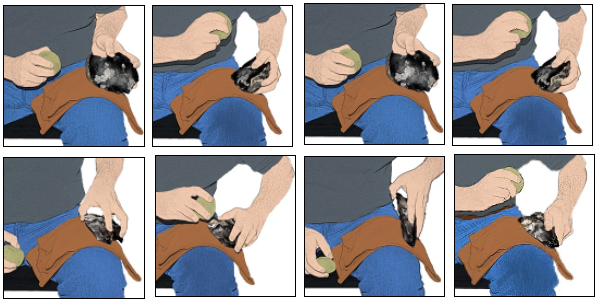A new way to measure
tech complexity
Scientists decode the brain's
'alphabet' and 'grammar' for action
to study behavioral evolution

As humans evolved our brains became bigger and our technology became more complex. While brains can be compared by size and other concrete measures of form and physiology, quantifying technological complexity has proven more challenging.
“Although we know that some human technologies have grown more complex and sophisticated with time, we actually don’t know exactly what we mean when we say that because we haven’t had a good way to measure that complexity,” says Dietrich Stout, associate professor of anthropology at Emory University. “Is a straight razor more, or less complex, than a baseball bat? Are Polynesian fishing nets more, or less, complicated than lassoes used by reindeer herders in Lapland?”
Now, Stout and colleagues have developed the first computational method to measure fluid human actions to try to answer such questions. Scientific Reports published their method, based on the making and use of different types of Stone Age tools.
Their data-driven approach provides a statistical representation for human behaviors. They used the method to compare the simple sequences needed to make stone flake blades, dating back more than two million years, to the more sophisticated, hierarchical “grammar” needed to fashion a hand axe, beginning around half-a-million years ago.
“We are now able to describe both types of behaviors using the same ‘alphabet,’” Stout says. “And we can show how the same ‘letters’ that underlie both types of stone tool-making are put together with simple versus complex ‘grammars.’”
The researchers plan to use their method to test the theory that the evolution of human behaviors, from tool making to language, relied on a unique capacity for hierarchical action sequencing. The new method may also have potential applications for everything from sports science to comparative psychology and clinical neurology.
“We’re trying to understand what behaviors and neural mechanisms set the stage for language,” Dietrich Stout says.
“Stone tool-making gives us a window into what humans were doing before the emergence of language.”
“It's a view that we don’t have at such depth, and at such a fine level of concrete detail, for any other activity.”
Stout studies the evolution of the human brain and mind through experimental archeology techniques. Participants actually make prehistoric tools from stone, a process known as knapping. In previous research, Stout has shown the relationship between the degree of activity in the prefrontal brain — including areas linked to language processing — and the ability to make a stone hand axe.
“For the past two million years, stone tool-making has been the most common and consistent human technology,” Stout says. “It’s an important human behavior that probably helped shape our brains.”
Simple Oldowan stone flakes are the earliest known tools, dating back more than 2.5 million years, before the human family emerged. The Late Acheulean hand axe, going back 500,000 years, embodies a much higher level of sophistication with its refined teardrop shape and edges thinned to expert sharpness and symmetry. It is considered a watershed tool that points to our shift from more ape-like hominids into full-fledged humans.
For the latest paper, Stout collaborated with Thierry Chaminade, a neuroscientist at Aix-Marseille University in France, and Aldo Faisal, a computational biologist from Imperial College London. The complex project was more than 15 years in the making.
“This work was truly interdisciplinary,” Stout says. “It took a lot just for us to learn to talk to one another across our different specialties.”
The study focused on tool-making methods from the early and late Lower Palelolithic, a period that spanned a nearly threefold increase in hominin brain size.
Expert knappers were recorded on video while creating simple, Oldowan sharp-edged stone flakes, made by striking one stone with another, and Acheulean hand axes, which require more intentional shaping.
During the Oldowan tool-making process, simple flake blades are chipped off a core, or base, stone (top).
In the Acheulean tool-making process, flakes are chipped away from a core stone and then finer finishing work is needed to shape the core into a symmetrical hand axe.
The researchers used the videos to identify a shared action “alphabet” of seven event types encompassing the elementary body movements and object transformations present in every sequence of both technologies.
They then applied statistical algorithms, including Markov modeling, to uncover structure within the tool-making process. A basic Markov model treats behavior as a simple chain of stimulus and response, with each event determining the probability of what happens next with no memory of anything before. The researchers applied a more sophisticated Markov model that can also identify persistent conditions, or “hidden states,” that influence behavior over time. This model can describe more complex, context-sensitive behaviors. For instance, if someone is going outside, knowing the “hidden state” of the weather (sunny or raining) provides a better chance of correctly predicting whether they will grab the umbrella by the door as they exit.
Similarly, during stone tool-making, if it is known that a knapper is in the later stages of refining a stone core for a hand axe, it is more likely that the action will involve particular ways of turning the core over in the hands and making light brush strokes against the core, as opposed to the simple series of hard strikes involved in the initial “roughing out” of the form. The researchers used the number of such hidden technological states in Oldowan and Acheulean knapping as a handy measure of complexity.
“The finer detail work that goes into the hand axe, getting the edges of the stone core to break just the way you want them to, is very different from just slamming the core hard to break off a flake,” Stout explains. “You need to do various things to get better control. We call that platform preparation.”
The researchers also applied algorithms used in formal language theory to help extract a “grammatical” rulebook for tool-making sequences. This enabled them to compress sequences of actions that occur repeatedly into single data points, or grammar rules. In effect, they used the amount of compression achieved on different tool-making sequences as another measure of structural complexity. The more patterning present in the behavior, the more rules are discovered and the greater the compression.
The results of the different methods of statistical analyses were consistent. Each indicated that making a hand axe is roughly twice as complex as making a stone flake tool, even when measured in very different ways.
“We were able to show that the Acheulean technological process is twice as complicated as Oldowan tool-making,” Stout says. “It took humans a couple of million years to make that technological leap. Now we can actually computationally measure and quantify this important step in evolution.”

Drawings show some of the steps involved in Oldowan tool-making (top) versus an Acheulean hand axe (bottom). (Stout Lab images)
Drawings show some of the steps involved in Oldowan tool-making (top) versus an Acheulean hand axe (bottom). (Stout Lab images)
The researchers then went a step further and used their new method to analyze fMRI scans of the brains of knappers while they watched the videos of making both a stone flake and a hand axe. The results were consistent with previous research, showing an area of the brain, the inferior frontal gyrus (IFG), responds specifically to hierarchal action sequences. And the activity in the IFG grows stronger in relation to an increase in the complexity of the tool-making process, as quantified by the new method of measuring technological complexity.
The IFG region also includes the “Broca’s area,” a part of the brain key to language processing.
Now that they have proof of concept for their new method, the researchers are using it to chip away at mysteries surrounding the evolution of language.
“We’re trying to understand what behaviors and neural mechanisms set the stage for language,” Stout explains. “Stone tool-making gives us a window into what humans were doing before the emergence of language that we don’t have at such depth, and at such a fine level of concrete detail, for any other activity.”
How language emerged is one of the biggest questions in science, he adds.
“The origin of language is often compared to the origin of multi-cellular life in terms of a major evolutionary transition,” Stout says. “Language allowed humans to inherit culture and knowledge in a way that keeps accumulating.”
Co-authors of the paper include Jan Apel from Stockholm University, and Ali Shafti, from Imperial College London. The work was supported by the Commission of the European Communities Research Directorate, the National Science Foundation and a UKRI Turing A.I. Fellowship grant.
Story by Carol Clark
For more information:
Dietrich Stout's Paleolithic Technology Laboratory,
Emory Department of Anthropology
Media inquiries: Carol Clark, carol.clark@emory.edu, 404-727-0501

